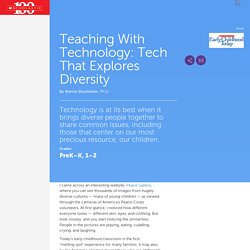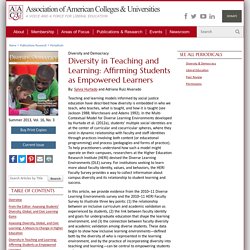

Teaching With Technology: Tech That Explores Diversity. I came across an interesting website, Peace Gallery, where you can see thousands of images from hugely diverse cultures — many of young children — as viewed through the cameras of America's Peace Corps volunteers.

At first glance, I noticed how different everyone looks — different skin, eyes, and clothing, But look closely, and you start noticing the similarities: People in the pictures are playing, eating, cuddling, crying, and laughing. Today's early childhood classroom is the first "melting-pot" experience for many families. It may also be the first time children meet others who are "different" from themselves. Here are some ways you can use technology to help children better understand one another and develop an appreciation for other cultures. Spotlight Similarities and Differences. How to Use Technology to Support ELLs in Your Classroom.
Quality edtech for ELLs isn't easy to find, but great options do exist.

English-language learners (ELLs) come into our classrooms with a wide variety of specific and unique needs for language acquisition. It's hard to talk about them all as one group -- ELLs represent a diverse range of students in every sense. It's needless to say: Working with ELLs is often challenging and also highly rewarding. Because there are so many apps and edtech tools available today, you might expect to find lots of them made specifically for English language development (ELD), bilingual, or dual-immersion classrooms. Unfortunately, this isn't the case: Tools designed specifically for English-language learners are few and far between (though there are definitely some out there).
There are, nevertheless, a lot of great edtech tools and strategies you can use with your ELLs, even if the tools themselves aren't ELL-specific. So, what's the best way to find and use great digital tools with your ELLs? 1. 2. 3. 4. How to teach your ELL's in the classroom. 9 Technology Tools To Engage Students In The Classroom - 10 Technology Tools To Engage Students In The Classroom contributed by Sara McGuire, venngage.com Technology distracts students, right? Keeps them from focusing? One solution is to ban phones and computers from the classroom. Another solution is to harness their tech-savvy and engage students with online tools that will help them complete assignments while still engaging them electronically. 5035b24fc662a.
How Technology in Classroom Can Enhance Student Learning. When it comes to the mind, there is so much the average individual doesn’t know. Take the idea of a growth mindset, for example. Many believe that our own abilities and our intelligence remained fixed after some point in time. Some think this happens at birth, while others may think it’s after college or university. How technology in class can enhance student learning Do's and Dont's. Diversity in Teaching and Learning: Affirming Students as Empowered Learners. Teaching and learning models informed by social justice education have described how diversity is embedded in who we teach, who teaches, what is taught, and how it is taught (see Jackson 1988; Marchesani and Adams 1992).

In the Multi-Contextual Model for Diverse Learning Environments developed by Hurtado et al. (2012a), students' multiple social identities are at the center of curricular and cocurricular spheres, where they exist in dynamic relationship with faculty and staff identities through practices involving both content (or educational programming) and process (pedagogies and forms of practice). To help practitioners understand how such a model might operate on their campuses, researchers at the Higher Education Research Institute (HERI) devised the Diverse Learning Environments (DLE) survey.
The Impact of an Inclusive Curriculum What is the impact of integrating diversity content into the curriculum and shifting pedagogy to include engagement with diverse peers and communities? 3 Ways Technology Can Help Promote Diversity in the Workplace. Traditional, unconscious biases have led to skewed hiring practices over the years, which in turn have led to a skewed workforce that is not gender or ethnically diverse.

Technology can step in and help change the status of diversity in the workplace and help businesses achieve more. Workplace diversity is defined as the inclusion of all individuals in an organization’s workforce, regardless of gender, religion, ethnicity, race, age, sexual orientation, and physical or mental fitness. HR experts have often debated the case of diversity and inclusion – is it just “good to do” to maintain an inclusive employer image, or is there a real benefit to business?
Let’s look at some statistics to back the case of ethnic and gender diversity in the workplace: Research by Morgan Stanley in 2016 found that companies with higher gender diversity delivered slightly better returns and moderately outperformed those with lower gender diversity, on average in the past five years. 1. 2. 3. 1. 2. 3. 4.